Toshiba G30 User Manual

User’s Manual
Qosmio G30

Copyright
© 2006 by TOSHIBA Corporation. All rights reserved. Under the copyright laws, this manual cannot be reproduced in any form without the prior written permission of TOSHIBA. No patent liability is assumed, with respect to the use of the information contained herein.
TOSHIBA Qosmio G30 Portable Personal Computer User’s Manual
First edition January 2006
Copyright authority for music, movies, computer programs, data bases and other intellectual property covered by copyright laws belongs to the author or to the copyright owner. Copyrighted material can be reproduced only for personal use or use within the home. Any other use beyond that stipulated above (including conversion to digital format, alteration, transfer of copied material and distribution on a network) without the permission of the copyright owner is a violation of copyright or author’s rights and is subject to civil damages or criminal action. Please comply with copyright laws in making any reproduction from this manual.
Disclaimer
This manual has been validated and reviewed for accuracy. The instructions and descriptions it contains are accurate for the TOSHIBA Qosmio G30 Portable Personal Computer at the time of this manual’s production. However, succeeding computers and manuals are subject to change without notice. TOSHIBA assumes no liability for damages incurred directly or indirectly from errors, omissions or discrepancies between the computer and the manual.
ii |
User’s Manual |

Trademarks
IBM is a registered trademark and IBM PC is a trademark of International Business Machines Corporation.
Intel, Intel SpeedStep, Intel Core, Celeron and Centrino are trademarks or registered trademarks of Intel Corporation.
Windows and Microsoft are registered trademarks of Microsoft Corporation. Photo CD is a trademark of Eastman Kodak.
Sonic RecordNow! and Sonic PrimeTime are registered trademarks of Sonic Solutions.
Bluetooth is a trademark owned by its proprietor and used by TOSHIBA under license.
Memory Stick is a registered trademark and i.LINK is a trademark of Sony Corporation.
InterVideo and WinDVD are registered trademarks of the InterVideo Inc. WinDVD Creator is a trademark of InterVideo Inc.
“Dolby” and the double-D symbol are trademarks of Dolby Laboratories. Confidential unpublished works. Copyright 1992-1997 Dolby Laboratories. All rights reserved.
EdgeMotion, PalmCheck, Touch Pad and Synaptics are trademarks or registered trademarks of Synaptics Incorporated.
Other trademarks and registered trademarks not listed above may be used in this manual.
Macrovision License
This product includes copyright protection technology and intellectual property that are patented in the U.S. and other countries. These patents are the property of Macrovision Corporation. The use of copyright protection must be authorized by Macrovision Corporation. It is intended for home and other restricted-use applications, unless Macrovision Corporation expressly authorizes otherwise. All forms of reverse engineering or decompiling are forbidden.
EU Declaration of Conformity
This product is carrying the CE-Mark in accordance with the related European Directives. Responsible for CE-Marking is TOSHIBA Europe GmbH, Hammfelddamm 8, 41460 Neuss, Germany.
The complete and official EU Declaration of Conformity can be found on TOSHIBA’s web site http://epps.toshiba-teg.com on the Internet.
User’s Manual |
iii |

Modem warning notice
Conformity Statement
The equipment has been approved to [Commission Decision “CTR21”] for pan-European single terminal connection to the Public Switched Telephone Network (PSTN).
However, due to differences between the individual PSTNs provided in different countries/regions the approval does not, of itself, give an unconditional assurance of successful operation on every PSTN network termination point.
In the event of problems, you should contact your equipment supplier in the first instance.
Network Compatibility Statement
This product is designed to work with, and is compatible with the following networks. It has been tested to and found to conform with the additional requirements conditional in EG 201 121.
Germany |
ATAAB AN005,AN006,AN007,AN009,AN010 |
|
and DE03,04,05,08,09,12,14,17 |
Greece |
ATAAB AN005,AN006 and GR01,02,03,04 |
Portugal |
ATAAB AN001,005,006,007,011 and |
|
P03,04,08,10 |
Spain |
ATAAB AN005,007,012, and ES01 |
Switzerland |
ATAAB AN002 |
All other countries/regions |
ATAAB AN003,004 |
Specific switch settings or software setup are required for each network, please refer to the relevant sections of the user guide for more details.
The hookflash (timed break register recall) function is subject to separate national type approvals. It has not been tested for conformity to national type regulations, and no guarantee of successful operation of that specific function on specific national networks can be given.
Following information is only for EU-member states:
The use of the symbol indicates that this product may not be treated as household waste. By ensuring this product is disposed of correctly, you will help prevent potential negative consequences for the environment and human health, which could otherwise be caused by inappropriate waste handling of this product. For more detailed information about recycling of this product, please contact your local city office, your household waste disposal service or the shop where you purchased the product.
iv |
User’s Manual |
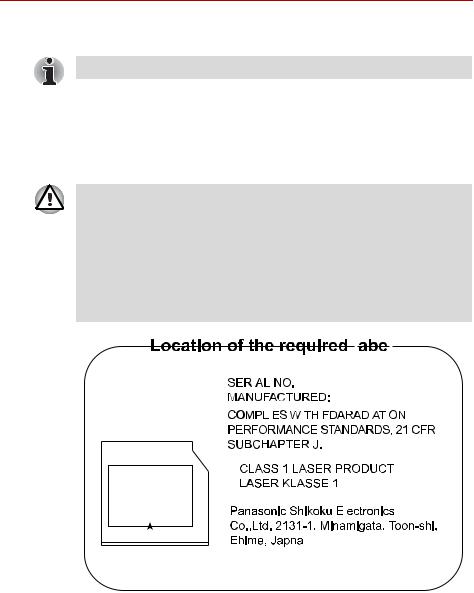
Optical disc drive safety instructions
Be sure to check the international precautions at the end of this section.
Panasonic Shikoku
DVD Super Multi with Double Layer Recording UJ-846
■The DVD Super Multi drive with Double Layer Recording model employs a laser system. To ensure proper use of this product, please read this instruction manual carefully and retain for future reference. Should the unit ever require maintenance, contact an authorized service location.
■Use of controls, adjustments or the performance of procedures other than those specified may result in hazardous radiation exposure.
■To prevent direct exposure to the laser beam, do not try to open the enclosure.
|
|
|
|
|
|
|
|
|
|
|
|
|
|
|
|
|
|
|
|
|
|
|
|
|
|
|
|
|
|
|
|
|
|
|
|
|
|
|
|
|
|
|
|
|
|
|
|
|
|
|
|
|
|
|
|
|
|
|
|
|
|
|
|
|
|
|
|
|
|
|
|
|
|
|
|
|
|
|
|
|
|
|
|
|
|
|
|
|
|
|
|
|
|
|
|
|
|
|
|
|
|
|
|
|
|
|
|
|
|
|
|
|
|
|
|
|
|
|
|
|
|
|
|
|
|
|
|
|
|
|
|
|
|
|
|
|
|
|
|
|
|
|
|
|
|
|
|
|
|
|
|
|
|
|
|
|
|
|
|
|
|
|
|
|
|
|
|
|
|
|
|
|
|
|
|
|
|
|
|
|
|
|
|
|
|
|
|
|
|
|
|
|
|
|
|
|
|
|
|
|
|
|
|
|
|
|
|
|
|
|
|
|
|
|
|
|
|
|
|
|
|
|
|
User’s Manual |
|
|
|
|
|
|
|
|
|
|
|
|
v |
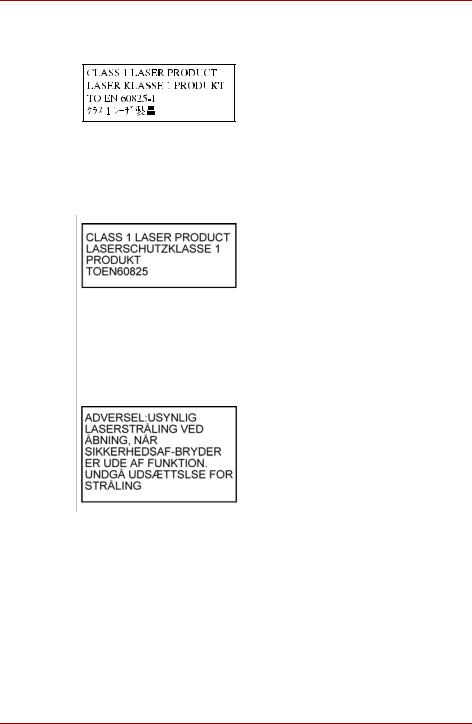
International precautions
CAUTION: This appliance contains a laser system and is classified as a “CLASS 1 LASER PRODUCT.” To use this model properly, read the instruction manual carefully and keep this manual for your future reference. In case of any trouble with this model, please contact your nearest “AUTHORIZED service station.” To prevent direct exposure to the laser beam, do not try to open the enclosure.
VORSICHT: Dieses Gerät enthält ein Laser-System und ist als “LASERSCHUTZKLASSE 1 PRODUKT” klassifiziert. Für den richtigen Gebrauch dieses Modells lesen Sie bitte die Bedienungsanleitung sorgfältig durch und bewahren diese bitte als Referenz auf. Falls Probleme mit diesem Modell auftreten, benachrichtigen Sie bitte die nächste “autorisierte Service-Vertretung”. Um einen direkten Kontakt mit dem Laserstrahl zu vermeiden darf das Gerät nicht geöffnet werden.
ADVARSEL: Denne mærking er anbragt udvendigt på apparatet og indikerer, at apparatet arbejder med laserstråler af klasse 1, hviket betyder, at der anvendes laserstrlier af svageste klasse, og at man ikke på apparatets yderside kan bilve udsat for utilladellg kraftig stråling.
APPARATET BOR KUN ÅBNES AF
FAGFOLK MED SÆRLIGT KENDSKAB
TIL APPARATER MED
LASERSTRÅLER!
Indvendigt i apparatet er anbragt den her gengivne advarselsmækning, som advarer imod at foretage sådanne indgreb i apparatet, at man kan komme til at udsatte sig for laserstråling.
vi |
User’s Manual |

OBS! Apparaten innehåller laserkomponent som avger laserstråining överstigande gränsen för laserklass 1.
VAROITUS. Suojakoteloa si saa avata. Laite sisältää laserdiodin, joka lähetää näkymätöntä silmilie vaarallista lasersäteilyä.
CAUTION: USE OF CONTROLS OR ADJUSTMENTS OR PERFORMANCE OF PROCEDURES OTHER THAN THOSE SPECIFIED IN THE OWNER’S MANUAL MAY RESULT IN HAZARDOUS RADIATION EXPOSURE.
VORSICHT: DIE VERWENDUNG VON ANDEREN STEURUNGEN ODER EINSTELLUNGEN ODER DAS DURCHFÜHREN VON ANDEREN VORGÄNGEN ALS IN DER BEDIENUNGSANLEITUNG BESCHRIEBEN KÖNNEN GEFÄHRLICHE STRAHLENEXPOSITIONEN ZUR FOLGE HABEN.
User’s Manual |
vii |

viii |
User’s Manual |

Table of Contents
Preface
General Precautions
Chapter 1 Introduction
Equipment checklist. . . . . . . . . . . . . . . . . . . . . . . . . . . . . . . . . . . . . . . 1-1 Features. . . . . . . . . . . . . . . . . . . . . . . . . . . . . . . . . . . . . . . . . . . . . . . . . 1-3 Special features . . . . . . . . . . . . . . . . . . . . . . . . . . . . . . . . . . . . . . . . . 1-10 Utilities. . . . . . . . . . . . . . . . . . . . . . . . . . . . . . . . . . . . . . . . . . . . . . . . . 1-12 Options . . . . . . . . . . . . . . . . . . . . . . . . . . . . . . . . . . . . . . . . . . . . . . . . 1-15
Chapter 2 The Grand Tour
Front with the display closed . . . . . . . . . . . . . . . . . . . . . . . . . . . . . . . 2-1 Left side . . . . . . . . . . . . . . . . . . . . . . . . . . . . . . . . . . . . . . . . . . . . . . . . . 2-2 Right side . . . . . . . . . . . . . . . . . . . . . . . . . . . . . . . . . . . . . . . . . . . . . . . 2-4 Back side. . . . . . . . . . . . . . . . . . . . . . . . . . . . . . . . . . . . . . . . . . . . . . . . 2-5 Underside . . . . . . . . . . . . . . . . . . . . . . . . . . . . . . . . . . . . . . . . . . . . . . . 2-7 Front with the display open. . . . . . . . . . . . . . . . . . . . . . . . . . . . . . . . . 2-8 System indicators. . . . . . . . . . . . . . . . . . . . . . . . . . . . . . . . . . . . . . . . 2-10 Optical media drives . . . . . . . . . . . . . . . . . . . . . . . . . . . . . . . . . . . . . 2-12 AC adaptor . . . . . . . . . . . . . . . . . . . . . . . . . . . . . . . . . . . . . . . . . . . . . 2-15
Chapter 3 Getting Started
Setting up your work space. . . . . . . . . . . . . . . . . . . . . . . . . . . . . . . . . 3-1 Connecting the AC adaptor . . . . . . . . . . . . . . . . . . . . . . . . . . . . . . . . . 3-6 Opening the display . . . . . . . . . . . . . . . . . . . . . . . . . . . . . . . . . . . . . . . 3-9 Turning on the power . . . . . . . . . . . . . . . . . . . . . . . . . . . . . . . . . . . . . . 3-9 Starting up for the first time . . . . . . . . . . . . . . . . . . . . . . . . . . . . . . . 3-10 Turning off the power. . . . . . . . . . . . . . . . . . . . . . . . . . . . . . . . . . . . . 3-10 Restarting the computer . . . . . . . . . . . . . . . . . . . . . . . . . . . . . . . . . . 3-14 Restoring the preinstalled software . . . . . . . . . . . . . . . . . . . . . . . . . 3-14
User’s Manual |
ix |

Chapter 4 Operating Basics
Using the Touch Pad . . . . . . . . . . . . . . . . . . . . . . . . . . . . . . . . . . . . . . .4-1 Using optical media drives . . . . . . . . . . . . . . . . . . . . . . . . . . . . . . . . . .4-2 Writing CD/DVDs on DVD Super Multi drive . . . . . . . . . . . . . . . . . . . .4-4 Media care. . . . . . . . . . . . . . . . . . . . . . . . . . . . . . . . . . . . . . . . . . . . . . .4-12 TV Tuner . . . . . . . . . . . . . . . . . . . . . . . . . . . . . . . . . . . . . . . . . . . . . . . .4-14 Sound System . . . . . . . . . . . . . . . . . . . . . . . . . . . . . . . . . . . . . . . . . . .4-16 Modem. . . . . . . . . . . . . . . . . . . . . . . . . . . . . . . . . . . . . . . . . . . . . . . . . .4-18 Wireless communications . . . . . . . . . . . . . . . . . . . . . . . . . . . . . . . . . .4-21 LAN . . . . . . . . . . . . . . . . . . . . . . . . . . . . . . . . . . . . . . . . . . . . . . . . . . . .4-25 Cleaning the computer . . . . . . . . . . . . . . . . . . . . . . . . . . . . . . . . . . . .4-26 Moving the computer. . . . . . . . . . . . . . . . . . . . . . . . . . . . . . . . . . . . . .4-27
Chapter 5 The Keyboard
Typewriter keys . . . . . . . . . . . . . . . . . . . . . . . . . . . . . . . . . . . . . . . . . . .5-1 Function keys: F1 … F12 . . . . . . . . . . . . . . . . . . . . . . . . . . . . . . . . . . .5-2 Soft keys: Fn key combinations . . . . . . . . . . . . . . . . . . . . . . . . . . . . . .5-2 Hot keys . . . . . . . . . . . . . . . . . . . . . . . . . . . . . . . . . . . . . . . . . . . . . . . . .5-3 Windows special keys . . . . . . . . . . . . . . . . . . . . . . . . . . . . . . . . . . . . . .5-6 Keypad overlay. . . . . . . . . . . . . . . . . . . . . . . . . . . . . . . . . . . . . . . . . . . .5-7 Generating ASCII characters. . . . . . . . . . . . . . . . . . . . . . . . . . . . . . . . .5-8
Chapter 6 Power
Power conditions . . . . . . . . . . . . . . . . . . . . . . . . . . . . . . . . . . . . . . . . . .6-1 Power indicators . . . . . . . . . . . . . . . . . . . . . . . . . . . . . . . . . . . . . . . . . .6-2 Battery types. . . . . . . . . . . . . . . . . . . . . . . . . . . . . . . . . . . . . . . . . . . . . .6-3 Care and use of the battery pack . . . . . . . . . . . . . . . . . . . . . . . . . . . . .6-6 Replacing the battery pack . . . . . . . . . . . . . . . . . . . . . . . . . . . . . . . . .6-12 TOSHIBA Password Utility . . . . . . . . . . . . . . . . . . . . . . . . . . . . . . . . .6-14 Starting the computer by password . . . . . . . . . . . . . . . . . . . . . . . . . .6-15 Power-up modes . . . . . . . . . . . . . . . . . . . . . . . . . . . . . . . . . . . . . . . . .6-16 Panel power on/off . . . . . . . . . . . . . . . . . . . . . . . . . . . . . . . . . . . . . . . .6-16 System Auto Off . . . . . . . . . . . . . . . . . . . . . . . . . . . . . . . . . . . . . . . . . .6-16
Chapter 7 HW Setup
Accessing HW Setup . . . . . . . . . . . . . . . . . . . . . . . . . . . . . . . . . . . . . . .7-1 HW Setup window . . . . . . . . . . . . . . . . . . . . . . . . . . . . . . . . . . . . . . . . .7-1 Other settings. . . . . . . . . . . . . . . . . . . . . . . . . . . . . . . . . . . . . . . . . . . . .7-7
x |
User’s Manual |

Chapter 8 Using the Remote Controller, Front operation panel and
QosmioPlayer
Windows XP Media Center Edition . . . . . . . . . . . . . . . . . . . . . . . . . . . 8-1 Front operation panel. . . . . . . . . . . . . . . . . . . . . . . . . . . . . . . . . . . . . . 8-2 Remote Controller . . . . . . . . . . . . . . . . . . . . . . . . . . . . . . . . . . . . . . . . 8-5 Using the Remote Controller. . . . . . . . . . . . . . . . . . . . . . . . . . . . . . . . 8-9 Installing/Removing batteries . . . . . . . . . . . . . . . . . . . . . . . . . . . . . . 8-12 Watching TV . . . . . . . . . . . . . . . . . . . . . . . . . . . . . . . . . . . . . . . . . . . . 8-14 QosmioPlayer . . . . . . . . . . . . . . . . . . . . . . . . . . . . . . . . . . . . . . . . . . . 8-16 Front operation panel. . . . . . . . . . . . . . . . . . . . . . . . . . . . . . . . . . . . . 8-16 List of language codes. . . . . . . . . . . . . . . . . . . . . . . . . . . . . . . . . . . . 8-25
Chapter 9 Optional Devices
PC card . . . . . . . . . . . . . . . . . . . . . . . . . . . . . . . . . . . . . . . . . . . . . . . . . 9-2 ExpressCard . . . . . . . . . . . . . . . . . . . . . . . . . . . . . . . . . . . . . . . . . . . . . 9-3 Bridge media slot . . . . . . . . . . . . . . . . . . . . . . . . . . . . . . . . . . . . . . . . . 9-5 Memory expansion . . . . . . . . . . . . . . . . . . . . . . . . . . . . . . . . . . . . . . . 9-12 Battery Packs . . . . . . . . . . . . . . . . . . . . . . . . . . . . . . . . . . . . . . . . . . . 9-16 Universal AC Adaptor . . . . . . . . . . . . . . . . . . . . . . . . . . . . . . . . . . . . 9-16 Battery Charger . . . . . . . . . . . . . . . . . . . . . . . . . . . . . . . . . . . . . . . . . 9-16 Hard disk drive pack. . . . . . . . . . . . . . . . . . . . . . . . . . . . . . . . . . . . . . 9-16 USB floppy disk drive . . . . . . . . . . . . . . . . . . . . . . . . . . . . . . . . . . . . 9-18 External monitor . . . . . . . . . . . . . . . . . . . . . . . . . . . . . . . . . . . . . . . . . 9-20 TV . . . . . . . . . . . . . . . . . . . . . . . . . . . . . . . . . . . . . . . . . . . . . . . . . . . . . 9-21 HDMI . . . . . . . . . . . . . . . . . . . . . . . . . . . . . . . . . . . . . . . . . . . . . . . . . . 9-23 S-Video-in . . . . . . . . . . . . . . . . . . . . . . . . . . . . . . . . . . . . . . . . . . . . . . 9-25 i.LINK (IEEE1394). . . . . . . . . . . . . . . . . . . . . . . . . . . . . . . . . . . . . . . . 9-26 Bluetooth USB Adaptor . . . . . . . . . . . . . . . . . . . . . . . . . . . . . . . . . . . 9-27 Security lock . . . . . . . . . . . . . . . . . . . . . . . . . . . . . . . . . . . . . . . . . . . . 9-28
Chapter 10 Troubleshooting
Problem solving process. . . . . . . . . . . . . . . . . . . . . . . . . . . . . . . . . . 10-1 Hardware and system checklist . . . . . . . . . . . . . . . . . . . . . . . . . . . . 10-3 TOSHIBA support . . . . . . . . . . . . . . . . . . . . . . . . . . . . . . . . . . . . . . . 10-20
Chapter 11 Legal Footnotes
Appendix A Specifications
Physical Dimensions . . . . . . . . . . . . . . . . . . . . . . . . . . . . . . . . . . . . . . A-1
Appendix B Display Controller and Modes
Display controller . . . . . . . . . . . . . . . . . . . . . . . . . . . . . . . . . . . . . . . . . B-1
Video modes . . . . . . . . . . . . . . . . . . . . . . . . . . . . . . . . . . . . . . . . . . . . . B-2
PowerMizer . . . . . . . . . . . . . . . . . . . . . . . . . . . . . . . . . . . . . . . . . . . . . B-10
User’s Manual |
xi |

Appendix C Wireless LAN
Card Specifications . . . . . . . . . . . . . . . . . . . . . . . . . . . . . . . . . . . . . . . C-1
Radio Characteristics . . . . . . . . . . . . . . . . . . . . . . . . . . . . . . . . . . . . . C-2
Supported Frequency Sub-bands. . . . . . . . . . . . . . . . . . . . . . . . . . . . C-3
Appendix D TOSHIBA RAID
Setting up Windows Manually. . . . . . . . . . . . . . . . . . . . . . . . . . . . . . . D-2 Starting, Modifying and Ending the BIOS Setup Program . . . . . . . . D-4
Appendix E Bluetooth wireless technology Interoperability
Bluetooth wireless technology and your Health . . . . . . . . . . . . . . . . E-3 Regulatory statements. . . . . . . . . . . . . . . . . . . . . . . . . . . . . . . . . . . . . E-3 Using Bluetooth™ Card from TOSHIBA equipment in Japan . . . . . E-6
Appendix F AC Power Cord and Connectors
Certification agencies . . . . . . . . . . . . . . . . . . . . . . . . . . . . . . . . . . . . . F-1
Appendix G Usage Restrictions
Appendix H If your computer is stolen
Glossary
Index
xii |
User’s Manual |

Preface
Congratulations on your purchase of the Qosmio G30 computer. This powerful notebook computer provides excellent expansion capability, including multimedia devices, and it is designed to provide years of reliable, high-performance computing.
Your computer is equipped with a built-in TV tuner. When you wish to display a TV program or play a CD/DVD before Windows starts, press the TV button or the CD/DVD button (or the same buttons on the remote control) respectively. When Windows is running, you can display or record a TV program using the My TV feature of Media Center.
This manual tells how to set up and begin using your Qosmio G30 computer. It also provides detailed information on configuring your computer, basic operations and care, using optional devices and troubleshooting.
If you are a new user of computers or if you’re new to portable computing, first read over the Introduction and The Grand Tour chapters to familiarize yourself with the computer’s features, components and accessory devices. Then read Getting Started for step-by-step instructions on setting up your computer.
If you are an experienced computer user, please continue reading the preface to learn how this manual is organized, then become acquainted with this manual by browsing through its pages. Be sure to look over the Special features section of the Introduction, to learn about features that are uncommon or unique to the computers and carefully read HW Setup.
If you are going to install PC cards or connect external devices such as a monitor, be sure to read Chapter 9, Optional Devices.
Manual contents
This manual is composed of the following eleven chapters, eight appendixes, a glossary and an index.
Chapter 1, Introduction, is an overview of the computer’s features, capabilities, and options.
Chapter 2, The Grand Tour, identifies the components of the computer and briefly explains how they function.
Chapter 3, Getting Started, provides a quick overview of how to begin operating your computer and gives tips on safety and designing your work area.
User’s Manual |
xiii |

Preface
Chapter 4, Operating Basics, This chapter describes the basic operations of your computer and precautions when using it, as well as the handling of CDs/DVDs.
Chapter 5, The Keyboard, describes special keyboard functions including the keypad overlay and hot keys.
Chapter 6, Power, gives details on the computer’s power resources and battery save modes.
Chapter 7, HW Setup, explains how to configure the computer using the HW Setup program.
Chapter 8, Using the Remote Controller, Front operation panel and QosmioPlayer, This chapter explains how to use the Remote Controller on Windows XP Media Center Edition models as well as provides information about QosmioPlayer.
Chapter 9, Optional Devices, describes the optional hardware available.
Chapter 10, Troubleshooting, provides helpful information on how to perform some diagnostic tests, and suggests courses of action if the computer doesn’t seem to be working properly.
Chapter 11, Legal Footnotes, provides Legal Footnotes information related to your computer.
The Appendixes provide technical information about your computer.
The defines general computer terminology and includes a list of acronyms used in the text.
The Index quickly directs you to the information contained in this manual.
Conventions
This manual uses the following formats to describe, identify, and highlight terms and operating procedures.
Abbreviations
On first appearance, and whenever necessary for clarity, abbreviations are enclosed in parentheses following their definition. For example: Read Only Memory (ROM). Acronyms are also defined in the Glossary.
Icons
Icons identify ports, dials, and other parts of your computer. The indicator panel also uses icons to identify the components it is providing information on.
Keys
The keyboard keys are used in the text to describe many computer operations. A distinctive typeface identifies the key top symbols as they appear on the keyboard. For example, Enter identifies the Enter key.
xiv |
User’s Manual |
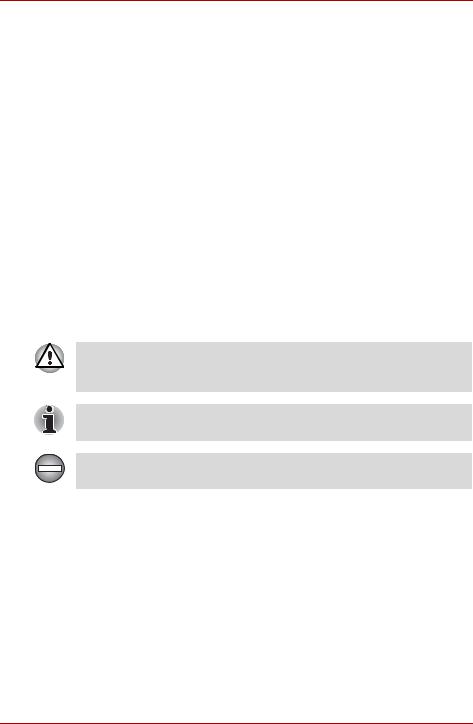
Preface
Key operation
Some operations require you to simultaneously use two or more keys. We identify such operations by the key top symbols separated by a plus sign (+). For example, Ctrl + C means you must hold down Ctrl and at the same time press C. If three keys are used, hold down the first two and at the same time press the third.
ABC |
When procedures require an action such as |
|
clicking an icon or entering text, the icon’s name |
|
or the text you are to type in is represented in the |
|
type face you see to the left. |
Display |
|
S ABC |
Names of windows or icons or text generated by |
the computer that appear on its display screen |
|
|
are presented in the type face you see to the left. |
Messages
Messages are used in this manual to bring important information to your attention. Each type of message is identified as shown below.
Pay attention! A caution informs you that improper use of equipment or failure to follow instructions may cause data loss or damage your equipment.
Please read. A note is a hint or advice that helps you make best use of your equipment.
Indicates a potentially hazardous situation, which could result in death or serious injury, if you do not follow instructions.
User’s Manual |
xv |

Preface
xvi |
User’s Manual |

General Precautions
TOSHIBA computers are designed to optimize safety, minimize strain and withstand the rigors of portability. However, certain precautions should be observed to further reduce the risk of personal injury or damage to the computer.
Be certain to read the general precautions below and to note the cautions included in the text of the manual.
Stress injury
Carefully read the Instruction Manual for Safety & Comfort. It contains information on prevention of stress injuries to your hands and wrists than can be caused by extensive keyboard use. Chapter 3, Getting Started, also includes information on workspace design, posture and lighting that can help reduce physical stress.
Heat injury
■Avoid prolonged physical contact with the computer. If the computer is used for long periods, its surface can become very warm. While the temperature will not feel hot to the touch, if you maintain physical contact with the computer for a long time (if you rest the computer on your lap, or if you keep your hands on the palm rest, for example) your skin might suffer low-heat injury.
■If the computer has been used for a long time, avoid direct contact with the metal plate supporting the I/O ports. It can become hot.
■The surface of the AC adaptor can become hot when in use. This condition does not indicate a malfunction. If you need to transport the AC adaptor, disconnect it and let it cool before moving it.
■Do not lay the AC adaptor on a material that is sensitive to heat. The material could be damaged.
Pressure or impact damage
Do not apply heavy pressure to the computer or subject it to strong impact. Excessive pressure or impact can cause damage to computer components or otherwise cause malfunctions.
User’s Manual |
xvii |
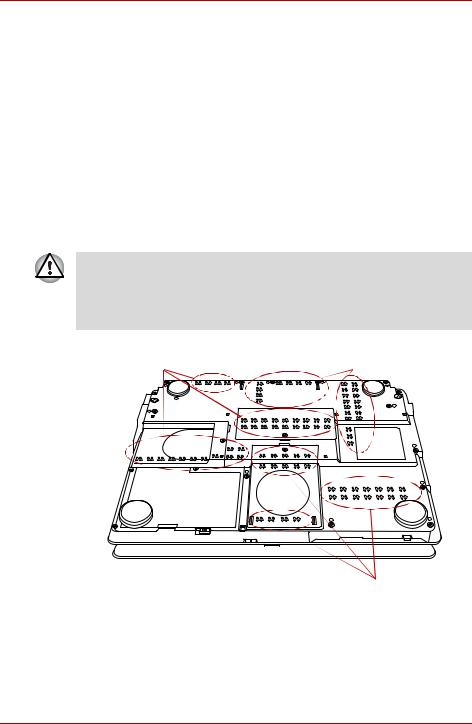
General Precautions
PC card overheating
Some PC cards can become hot with prolonged use. Overheating of a PC card can result in errors or instability in the PC card operation. Also be careful when you remove a PC card that has been used for a long time.
Mobile phone
Use of mobile phones can interfere with the audio system. Computer operation is not impaired but is recommended that a distance of 30 cm be maintained between the computer and a mobile phone in use.
Cooling
1. Cleaning of dust accumulated on the cooling vent of the computer.
When you use your computer in a dusty area, dirt and debris may accumulate on the cooling vents at the under side of your unit. If this occurs, the accumulated dust can cause insufficient heat dissipation which may result in the computer shutting down during use. Carefully clean the dust from the vents using a vacuum cleaner.
2. Cooling vents on the underside and back side of the computer.
Cooling vents |
Cooling vents |
|||||||||
|
|
|
|
|
|
|
|
|
|
|
|
|
|
|
|
|
|
|
|
|
|
|
|
|
|
|
|
|
|
|
|
|
|
|
|
|
|
|
|
|
|
|
|
|
|
|
|
|
|
|
|
|
|
|
|
|
|
|
|
|
|
|
|
|
|
|
|
|
|
|
|
|
|
|
|
|
Cooling vents
xviii |
User’s Manual |
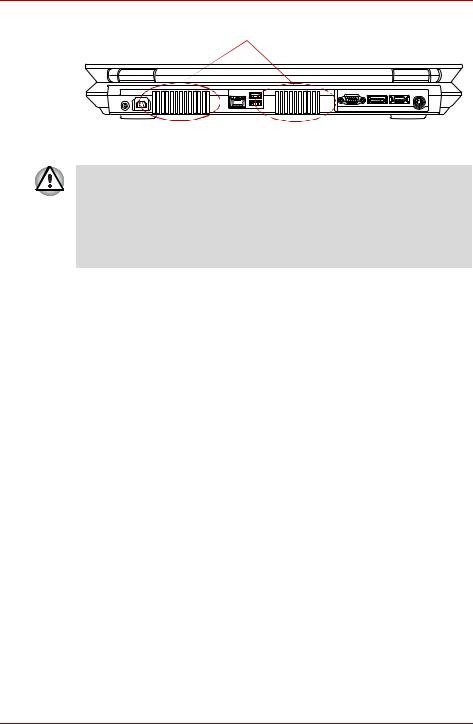
General Precautions
Cooling vents
Cooling vents
To prevent possible overheating of the CPU, make sure the cooling fan’s air intake is not blocked. The fan draws in air by creating a vacuum. If the fan is blocked, it could cause the CPU to run at a lower performance level or cause the computer to shut down. Loose items such as notebook and tissue paper, plastic wrappers, or other similar materials can block the air intake, preventing air from reaching the CPU. Do not use the computer on surfaces with objects that can be drawn in by the cooling fan.
User’s Manual |
xix |

General Precautions
xx |
User’s Manual |
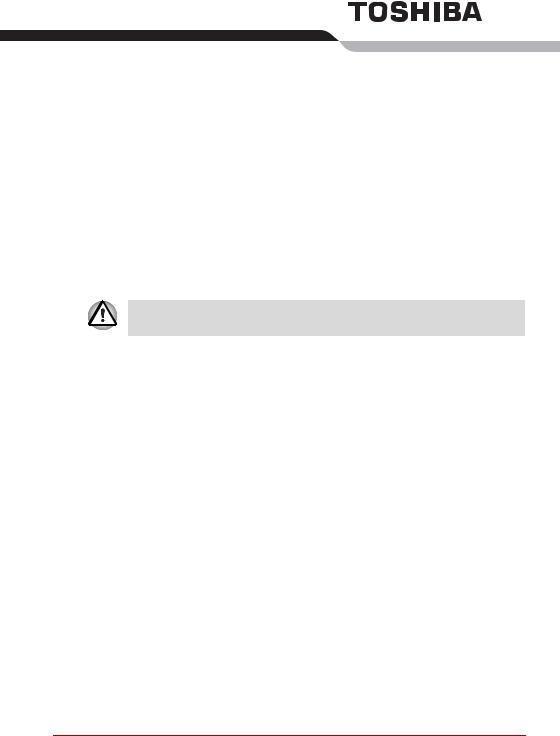
Chapter 1
Introduction
This chapter provides an equipment checklist, and it identifies the computer’s features, options and accessories.
Some of the features described in this manual may not function properly if you use an operating system that was not preinstalled by TOSHIBA.
Equipment checklist
Carefully unpack your computer. Save the box and packing materials for future use.
Hardware
Check to make sure you have all the following items:
■Qosmio G30 Portable Personal Computer
■AC adaptor and power cord
■Modular cable (optional)
■VIDEO-IN cable
■Remote Controller
■Remote control receiver with USB connector
■Infrared transmitter cable
■Antenna adaptor
■Two AA manganese batteries (for Remote Controller)
■D-Video out cable with Scart connector (optional)
User’s Manual |
1-1 |

Introduction
Software
Microsoft® Windows XP Media Center Edition
■The following software is preinstalled:
■Microsoft® Windows XP Media Center Edition
■TOSHIBA Utilities
■DVD Video Player
■InterVideo WinDVD Creator
■RecordNow! Basic for TOSHIBA
■DLA for TOSHIBA
■TOSHIBA Power Saver
■TOSHIBA ConfigFree
■TOSHIBA Assist
■TOSHIBA Controls
■TOSHIBA PC Diagnostic Tool
■TOSHIBA Touch and Launch
■TOSHIBA TouchPad On/Off Utility
■TOSHIBA Zooming Utility
■TOSHIBA Picture Enhancement Utility
■TOSHIBA SD Memory Card Format
■TOSHIBA Acoustic Silencer
■TOSHIBA Hotkey Utility for Display Devices
■TOSHIBA Display Device Change Utility
■TOSHIBA Password Utility
■TOSHIBA RAID Utility
■Bluetooth Stack for Windows by Toshiba (depending on the model purchased)
■DVD-RAM Driver
■Wireless Hotkey utility
■Display Driver
■Sound Driver
■Touch Pad Driver
■Modem Driver
■LAN Driver
■Wireless LAN Driver
■TV Tuner Driver
■Online manual
■Product Recovery DVD-ROM
■QosmioPlayer Recovery CD
1-2 |
User’s Manual |

Introduction
Documentation
■Qosmio G30 Portable Personal Computer User’s Manual
■Qosmio G30 Quickstart
■Microsoft Windows XP Media Center Edition Getting Started booklet
■Instruction Manual for Safety & Comfort
■QosmioPlayer Software License Agreement
■Warranty information
If any of the items are missing or damaged, contact your dealer immediately.
Features
The computer uses TOSHIBA’s advanced Large Scale Integration (LSI), Complementary Metal-Oxide Semiconductor (CMOS) technology extensively to provide compact size, minimum weight, low power usage, and high reliability. This computer incorporates the following features and benefits:
Processor
Built-in |
The computer is equipped with an Intel® Core™ |
|
Duo processor, which incorporates a 2MB level2 |
|
cache memory. |
|
It also supports Enhanced Intel® SpeedStep® |
|
Technology. |
|
|
Some models in this series carry Intel® Centrino® Duo Mobile Technology, which is based on three separate technologies of Intel® Core™ Duo processor, Intel® PRO/Wireless Network Connection, and Mobile Intel® 945 Express Chipset Family.
Legal Footnote (CPU)
For more information on the Legal Footnote regarding CPU, please refer to the Legal Footnotes section in Chapter 11.
Memory
Slots |
256, 512, 1,024 or 2,048 MB memory modules |
|
can be installed in the two memory slots for a |
|
maximum of 4,096 MB system memory. |
|
|
Legal Footnote (Memory (Main System)
For more information on the Legal Footnote regarding Memory (Main System), please refer to the Legal Footnotes section in Chapter 11.
User’s Manual |
1-3 |

Introduction
Video RAM |
There are two different types of graphics |
|
controllers. The Video RAM specifications will |
|
differ depending on the type of graphics |
|
controller used in the computer. |
|
■ nVIDIA GeForce Go 7300 model: 256MB of |
|
RAM is provided for video display. Part of |
|
system memory is used for Video RAM. |
|
When system memory of 1GB or more is |
|
installed, there is a total of 512MB (256MB of |
|
Video RAM + 256MB of system memory). |
|
■ nVIDIA GeForce Go 7600 model: 128/256MB |
|
of RAM is provided for video display. |
|
|
Power |
|
|
|
Battery pack |
The computer is powered by one rechargeable |
|
lithium-ion battery pack. |
|
|
Legal Footnote (Battery Life)
For more information on the Legal Footnote regarding Battery Life, please refer to the Legal Footnotes section in Chapter 11.
RTC battery |
The internal RTC battery backs up the Real Time |
|
Clock and calendar. |
|
|
AC adaptor |
The AC adaptor provides power to the system |
|
and recharges the batteries when they are low. It |
|
comes with a detachable power cord. |
|
Because it is universal, it can receive a range of |
|
AC voltage from 100 to 240 volts; however, the |
|
output current varies among different models. |
|
Using the wrong model can damage your |
|
computer. Refer to the AC adaptor section in |
|
Chapter 2, The Grand Tour. |
|
|
Disks |
|
|
|
Hard disk drive |
Available in five sizes. |
|
■ 40.0 billion bytes (37.26 GB) |
|
■ 60.0 billion bytes (55.88 GB) |
|
■ 80.0 billion bytes (74.52 GB) |
|
■ 100.0 billion bytes (93.16 GB) |
|
■ 120.0 billion bytes (111.79 GB) |
|
Two types of models are available: one with one |
|
hard disk drive and the other with two hard disk |
|
drives. |
|
|
1-4 |
User’s Manual |

Introduction
Legal Footnote (HDD Drive Capacity)
For more information on the Legal Footnote regarding HDD Drive Capacity, please refer to the Legal Footnotes section in Chapter 11.
USB floppy disk Accommodates either 3 1/2" 1.44-megabyte or drive (optional) 720-kilobyte floppy disks. It connects to a USB
port.
Optical media drive
DVD Super Multi This computer is equipped with a full-size DVD drive (Double Layer) Super Multi drive module that lets you record
data to rewritable CD/DVDs as well as run 12cm (4.72") CD/DVDs. It reads DVD-ROMs at maximum 8 speed and CD-ROMs at maximum 24 speed. It writes CD-R at up to 24 speed, CD-RW at up to 10 speed, DVD-R and DVD+R at maximum 8 speed, DVD-R DL at maximum 2 speed, DVD+R DL at maximum 2.4 speed, DVD-RW and DVD+RW at maximum 4 speed, DVD-RAM at maximum 5 speed. This drive supports the following formats:
■CD-R
■CD-RW
■DVD-ROM
■DVD-Video
■CD-DA
■CD-Text
■Photo CD™ (single/multi-session)
■CD-ROM Mode 1, Mode 2
■CD-ROM XA Mode 2 (Form1, Form2)
■Enhanced CD (CD-EXTRA)
■Addressing Method 2
■DVD-R
■DVD-R DL
■DVD-RW
■DVD+R
■DVD+R DL
■DVD+RW
■DVD-RAM
User’s Manual |
1-5 |
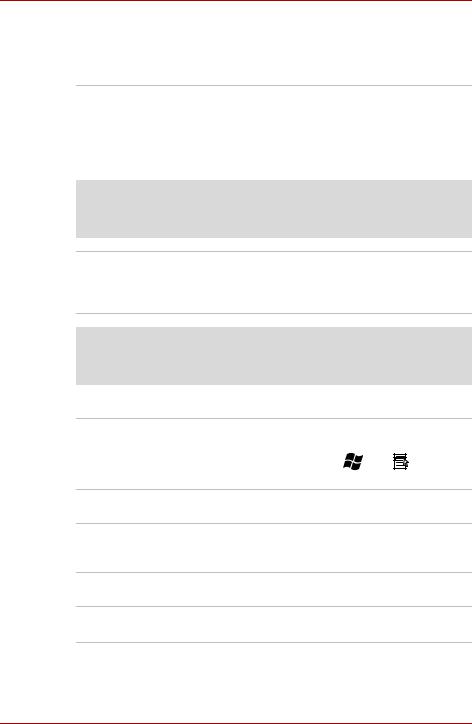
Introduction
Display
The computer’s LCD panel supports high-resolution video graphics. The screen can be set at a wide range of viewing angles for maximum comfort and readability.
Built-in |
17" TFT LCD screen, 32 M colors, with one of the |
|
|
following resolutions: |
|
|
■ |
WXGA+, 1440 horizontal × 900 vertical pixels |
|
■ |
WUXGA, 1920 horizontal × 1200 vertical |
|
|
pixels |
|
|
|
Legal Footnote (LCD)
For more information on the Legal Footnote regarding LCD, please refer to the Legal Footnotes section in Chapter 11.
Graphics controller Graphics controller maximizes display performance. Refer to Display Controller and Modes section in Appendix B for more information.
Legal Footnote (Graphics Processor Unit (“GPU”)
For more information on the Legal Footnote regarding Graphics Processor Unit (“GPU”), please refer to the Legal Footnotes section in Chapter 11.
Keyboard
Built-in |
85 keys or 86 keys, compatible with IBM® |
||
|
enhanced keyboard, embedded numeric overlay, |
||
|
dedicated cursor control, |
and |
keys. |
|
Refer to Chapter 5, The Keyboard, for details. |
||
Pointing Device
Built-in Touch Pad A Touch Pad and control buttons in the palm rest enable control of the on-screen pointer and scrolling of windows.
Ports
External monitor Analog VGA port supports VESA DDC2B compatible functions.
1-6 |
User’s Manual |

|
|
Introduction |
|
|
|
|
|
|
|
Universal Serial Bus |
The computer has Universal Serial Bus ports that |
|
(USB 2.0) |
comply with the USB 2.0 standard, which |
|
|
enables data transfer speeds 40 times faster |
|
|
than the USB 1.1 standard (The ports also |
|
|
support USB 1.1). |
|
|
|
|
i.LINK™ (IEEE1394) |
This port enables high-speed data transfer |
|
|
directly from external devices such as digital |
|
|
video cameras. |
|
|
|
|
Slots |
|
|
|
|
|
PC card |
The PC card slot accommodates a 5 mm Type II |
|
|
card. |
|
|
|
|
ExpressCard |
The ExpressCard slot accommodates an |
|
|
ExpressCard. |
|
|
|
|
Bridge media |
This slot lets you insert a SD card, Memory Stick |
|
|
(Pro), xD picture card and MultiMediaCard. Refer |
|
|
to Chapter 9, Optional Devices. |
|
|
|
|
Multimedia |
|
|
|
|
|
Sound system |
Windows sound system compatible sound |
|
|
system provides internal speakers and |
|
|
microphone as well as jacks for an external |
|
|
microphone and headphones. |
|
|
|
|
TV antenna port |
Connect the antenna adaptor to this port to watch |
|
|
TV programs on your computer or record them. |
|
|
|
|
S-Video-in Port |
A camcorder or other recording device can be |
|
|
connected to this port via the S-Video-in cable |
|
|
(optional) for importing video data. Refer to the |
|
|
S-Video-in section in Chapter 9, Optional |
|
|
Devices. |
|
|
|
|
S-Video out port |
This S-Video out port lets you transfer NTSC or |
|
|
PAL data to external devices. Refer to the TV |
|
|
section in Chapter 9, Optional Devices. |
|
|
|
|
D-Video out port |
This D-Video out port lets you transfer 525i |
|
|
(480i), 525p (480p), 1125i (1080i) or 750p (720p) |
|
|
data to external devices. Refer to the TV section |
|
|
in Chapter 9, Optional Devices. |
|
|
|
|
HDMI out port |
HDMI out port can connect with Type A |
|
|
connector HDMI cable. |
|
|
A HDMI cable can send and receive video, audio |
|
|
and control signals. |
|
|
|
User’s Manual |
1-7 |

Introduction
The computer is equipped with either an HDMI or D-Video out port.
Headphone (S/PDIF) |
This jack lets you connect digital speakers or |
jack |
stereo headphones (16 ohm minimum). When |
|
you connect a digital speaker or headphones, the |
|
internal speakers are automatically disabled. |
|
This jack can be used also as S/PDIF jack and |
|
enables connection of optical digital |
|
correspondence apparatus. |
|
|
Headphone jack |
A 3.5 mm mini headphone jack enables |
|
connection of stereo headphones. |
|
|
Microphone jack |
A 3.5 mm mini microphone jack enables |
|
connection of a three-conductor mini jack for |
|
monaural microphone input. |
|
|
Built-in TV Tuner |
Enables watching and recording TV programs. |
|
|
Infrared receiver |
This is a sensor window that receives signals |
window |
from the Remote Controller which is provided |
|
with your computer. |
|
This supports only Qosmio Player. |
|
|
Remote Controller |
Use this device to navigate when watching TV or |
|
playing CDs/DVDs. |
|
|
Remote control |
This is a sensor device that receives signals from |
receiver |
the Remote Controller which is provided with |
|
your computer. |
|
|
Communications |
|
|
|
Modem |
An internal modem provides capability for data |
|
and fax communication. The speed of data |
|
transfer and fax depends on analog telephone |
|
line conditions. It has a modem jack for |
|
connecting to a telephone line. Both of V.90 and |
|
V.92 are supported only in USA, Canada, UK, |
|
France, Germany and Australia. Only V.90 is |
|
available in other regions. |
|
|
LAN |
The computer has built-in support for Ethernet |
|
LAN (10 megabits per second, 10BASE-T), |
|
Fast Ethernet LAN (100 megabits per second, |
|
100BASE-TX) and Gigabit Ethernet LAN |
|
(1000 megabits per second, 1000BASE-T). |
|
|
1-8 |
User’s Manual |

|
|
Introduction |
|
|
|
|
|
|
|
Bluetooth |
Some computers in this series are equipped with |
|
|
Bluetooth functions. Bluetooth wireless |
|
|
technology eliminates the need for cables |
|
|
between electronic devices such as computers |
|
|
and printers. Bluetooth provides fast, reliable, |
|
|
and secure wireless communication in a small |
|
|
space. |
|
|
|
|
Wireless LAN |
Some computers in this series are equipped with |
|
|
a Wireless LAN mini-PCI card that is compatible |
|
|
with other LAN systems based on Direct |
|
|
Sequence Spread Spectrum/Orthogonal |
|
|
Frequency Division Multiplexing radio technology |
|
|
that complies with the IEEE 802.11 Standard |
|
|
(Revision A, B or G). |
■Theoretical maximum speed: 54 Mbps (IEEE802.11a, 802.11g)
■Theoretical maximum speed: 11 Mbps (IEEE802.11b)
■Frequency Channel Selection (5 GHz: Revision A / 2.4 GHz: Revision B/G)
■Roaming over multiple channels
■Card Power Management
■Wired Equivalent Privacy (WEP) data encryption, based on 152 bit encryption algorithm (Atheros module type).
■Wired Equivalent Privacy (WEP) data encryption, based on 128 bit encryption algorithm (Intel module type).
■Advanced Encryption Standard (AES) data encryption, based on 256 bit encryption algorithm.
■Wi-Fi Protected Access (WPA).
■Wake-up on Wireless LAN (Intel module type).
■The numerical values shown above are the theoretical maximums for Wireless LAN standards. The actual values may differ.
■The transmission speed over the wireless LAN and the distance over which wireless LAN can reach may vary depending on surrounding electromagnetic environment, obstacles, access point design and configuration, and client design and software/hardware configurations. The Transmit Rate (at X Mbit/s) is the theoretical maximum speed under the IEEE802.11 (a/b/g) standard. The actual transmission speed will be lower than the theoretical maximum speed.
■The Wake on Wireless function is effective only when it is connected with AP. This function becomes invalid when the connection is cut.
User’s Manual |
1-9 |

Introduction
Legal Footnote (Wireless LAN)
For more information on the Legal Footnote regarding Wireless LAN, please refer to the Legal Footnotes section in Chapter 11.
Wireless |
This switch turns the Wireless LAN and |
communication |
Bluetooth functions on and off. |
switch |
|
Security
Security lock slot Connects a security lock to anchor the computer to a desk or other large object.
Special features
The following features are either unique to TOSHIBA computers or are advanced features, which make the computer more convenient to use.
Hot keys |
Key combinations let you quickly change the |
|
system configuration directly from the keyboard |
|
without running a system configuration program. |
|
|
The Hot key functions are supported only under Windows, not supported under QosmioPlayer.
Display automatic |
This feature automatically cuts off power to the |
power off |
internal display when there is no keyboard input |
|
for a time specified. Power is restored when any |
|
key is pressed. You can specify the time in the |
|
Monitor power off item of the Basic Setup tab in |
|
TOSHIBA Power Saver. |
|
|
HDD automatic |
This feature automatically cuts off power to the |
power off |
hard disk drive when it is not accessed for a time |
|
specified. Power is restored when the hard disk is |
|
accessed. You can specify the time in the HDD |
|
power off item of the Basic Setup tab in TOSHIBA |
|
Power Saver. |
|
|
1-10 |
User’s Manual |
